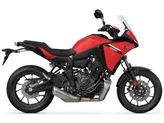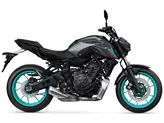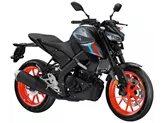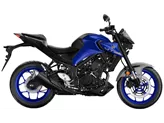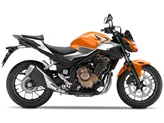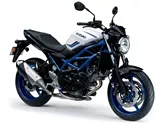Yamaha MT-07 2014 vs. Suzuki SV 650 2016

Yamaha MT-07 2014

Suzuki SV 650 2016
Overview - Yamaha MT-07 2014 vs Suzuki SV 650 2016
The Yamaha MT-07 2014 and the Suzuki SV 650 2016 are both naked bikes with similar engine types, cooling systems, and cylinder configurations. However, there are several key differences between the two models.
In terms of engine power, the Yamaha MT-07 2014 has a slightly lower output of 75 HP compared to the Suzuki SV 650 2016's 76 HP. However, the Yamaha MT-07 2014 has a higher torque of 68 Nm compared to the Suzuki SV 650 2016's 64 Nm. This means that the Yamaha MT-07 2014 may have slightly better acceleration and pulling power.
Both bikes have telescopic fork front suspensions and steel frames, which provide stability and control. The Yamaha MT-07 2014 has double disk front brakes, while the Suzuki SV 650 2016 also has double disk front brakes. This ensures powerful and reliable braking performance for both models.
In terms of tire dimensions, the Yamaha MT-07 2014 has a wider rear tire width of 180 mm compared to the Suzuki SV 650 2016's 160 mm. This may provide slightly better traction and stability for the Yamaha MT-07 2014.

Yamaha MT-07 2014
The wheelbase of the Yamaha MT-07 2014 is shorter at 1400 mm compared to the Suzuki SV 650 2016's 1445 mm. This may result in slightly more agile and maneuverable handling for the Yamaha MT-07 2014.
The seat height of the Yamaha MT-07 2014 is slightly higher at 805 mm compared to the Suzuki SV 650 2016's 785 mm. This may be more comfortable for taller riders on the Yamaha MT-07 2014.
In terms of weight, the Yamaha MT-07 2014 is lighter with a kerb weight of 182 kg compared to the Suzuki SV 650 2016's 197 kg. This may contribute to the Yamaha MT-07 2014's light and nimble handling.

Suzuki SV 650 2016
Both models have similar fuel tank capacities, with the Yamaha MT-07 2014 having a slightly larger capacity of 14 l compared to the Suzuki SV 650 2016's 13.8 l. This may result in slightly longer riding range for the Yamaha MT-07 2014.
In terms of strengths, the Yamaha MT-07 2014 is praised for its extremely agile engine, very light handling, low weight, aggressively angular appearance, powerful brakes, comfortable seating position, throaty sound, and extensive and easy-to-read display. On the other hand, the Suzuki SV 650 2016 is praised for its agile and powerful engine, typical V2 sound, pleasant and low seating position, easy handling, comfortable chassis, and brakes with good control.
However, the Yamaha MT-07 2014 does have some weaknesses, including a slightly soft suspension, footrests that drag quickly, partly cheap plastic parts, and a boring telescopic fork. The Suzuki SV 650 2016's only weakness mentioned is a poorly readable digital tachometer.
In conclusion, the Yamaha MT-07 2014 and the Suzuki SV 650 2016 are both solid naked bike options with their own strengths and weaknesses. The Yamaha MT-07 2014 may offer slightly better acceleration and handling, while the Suzuki SV 650 2016 may provide a more comfortable seating position and better control. Ultimately, the choice between the two models will depend on the rider's preferences and priorities.
Technical Specifications Yamaha MT-07 2014 compared to Suzuki SV 650 2016
Pros and Cons in comparison
Pros and Cons in comparison
Yamaha MT-07 2014

The MT-07 is an incredible fun machine that is extremely sporty to ride. The brakes pack a punch, the handling is superb and the engine is currently by far the most agile powerplant in this class - and even above.
Suzuki SV 650 2016

The new SV650 continues the visual minimalism of the first two SV650 generations, but builds technically on its direct predecessor, the SFV650 Gladius - two excellent moves that turn the very modern SV650 into a classic. The design fits wonderfully into the era of many retro conversions, but inside there are also modern gimmicks that make it easier for beginners in particular to get started. The engine, on the other hand, can also convince advanced riders; the typical V2 feeling is wonderful. You shouldn't expect extreme sportiness in the chassis and brakes, but the price of just under 6400 euros (in Germany) is a statement that the competition will have to swallow.
Price Comparison Avarage Market Price Yamaha MT-07 vs Suzuki SV 650
There are a few key differences between a Yamaha MT-07 2014 and a Suzuki SV 650 2016. In terms of price, the actual average price of a Yamaha MT-07 2014 is about 3% higher. A Yamaha MT-07 2014 experiences a loss of 160 GBP in one year and 220 GBP in two years of ownership. This is offset by a loss of 140 GBP and 140 GBP for a Suzuki SV 650 2016. Compared to Suzuki SV 650 2016 there are more Yamaha MT-07 2014 bikes available on the 1000PS.de Marketplace, specifically 17 compared to 11. It takes less time to sell a Yamaha MT-07 with 37 days compared to 80 days for a Suzuki SV 650. Since model year 2013 1000PS.de editors have written 69 reviews for the Yamaha MT-07 and 25 reviews for the Suzuki SV 650 since model year 2005. The first review for the Yamaha MT-07 was published on 04/11/2013 and now has more than 12,600 views. This compares to more than 14,200 views for the first review on Suzuki SV 650 published on 26/09/2008.


